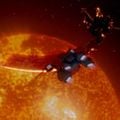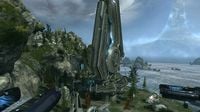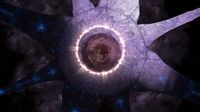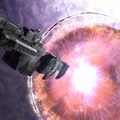Archive:Halo Waypoint/2014 to 2020/Universe/Locations
From Halopedia, the Halo wiki
Sites
Alpha Shard
Fragment of Installation 04
Navigation Code: Location-6201
Anomaly Classification: Type-R3
Orbital Period: [REDACTED]
Day/Night Cycle: ACCELERATED
Maximum Surface Temperature: 900 degrees F
Overview
In 2552, the SPARTAN-II super soldier known as Master Chief John-117 successfully detonated the fusion reactors of the Halcyon-class cruiser UNSC Pillar of Autumn, destroying the alien artifact known as Installation 04 (Alpha Halo). Nearly all of the resulting debris was confirmed to have either fallen into the gravitational fields of the gas-giant Threshold or its moon, Basis. The remaining shards and pieces formed a debris field that remained in orbit. While various UNSC craft have surveyed and studied pieces of the broken ring - including the UNSC Red Horse in late 2552 – at least 30% of its mass and curvature remain unaccounted. The whereabouts of the missing material/objects are unknown, and no viable conjecture can be given at this time.
Discovery & Deployment
In late 2555, information was obtained from an Automated UNSC Scout Vehicle, Recon-14, which immediately piqued the interests of the Office of Naval Intelligence (ONI). The signal emanated from an area deemed Location 6201 and was quickly analyzed by multiple ONI specialists analyzed. However, it was a scientist and ONI attaché for astrophysical phenomenon, Dr. Madeline Tress, who correctly surmised that the signal had indeed come from the missing fragment of Installation 04.
Recon-14 itself had been deployed from the UNSC Pillar of Autumn before the cruiser’s initial crash-landing on the Halo ring. The drone’s survival, paired with other evidence, strongly infers that at least part of the ring either instigated or was enveloped in a significant slipspace event – far in excess of both human and (known) Covenant technology. The common theory holds that Recon-14 became stranded when the Halo itself attempted to activate an emergency slipspace jump once the Autumn’s reactors went critical; perhaps as one of the installation’s many self-preservation protocols. The action would not be successful as the Autumn detonated before Alpha Halo could fully enact the procedure. As a result, only a [REDACTED]-size fragment of the Halo would make its escape. The subsequent jump however would send the fragment tumbling through space upon reentering normal space, where it was caught in the gravitational field of a nearby star.
Current Status
Currently, the fragment appears to be at least partially functioning, even to the point of attempting to continually reduce radiation levels. However, the fragment’s spin exposes it to the harsh radiation emanating from its anchoring star during the fragment’s “day” period, which lasts approximately every 16 hours.
Though ONI and the UNSC have attempted to learn all they can about the Halo Array, much of its secrets remain unexplained. Central to these mysteries is the nature of the Halo’s regenerative abilities and sustainability protocols. Despite the extreme damage and trauma inflicted on the installation, it still inexplicably retains certain functionality with regards to the preservation of its intended environmental conditions. This is including but not limited to gravitational field integrity, atmospheric composition, and even biodiversity levels. Further research on the extant ring material and systems prior to the quarantine strongly infers that the rings are made of multiple redundant systems, including slipspace engines, terraforming facilities, artificial gravity, and weather control. The true nature of how these areas are tended to, as well as a complete understanding as to the original intentions behind such designs, remains a mystery.
Alpha Halo
Installation 04
Affiliation: Forerunner
Star System: Soell
Gravity Anchor: Threshold/Basis
Monitor: 343 Guilty Spark
Diameter: 6,214 miles (10,000km)
Atmosphere: 1 (N2, O2)
Surface Temperature: -9°F to 104°F (-23°C to 40°C)
Summary
Over one hundred millennia ago, the Forerunners developed a collection of ringworlds, collectively called the Halo Array, in hopes of stopping the advancement of the merciless parasite known as the Flood. The firing of the Halo Array was the final effort by the Forerunners to save all life in the galaxy – ironically by destroying it, as the Array was meant to deprive the Flood of its food source: intelligent life.
Discovery
On September 19, 2552, humanity stumbled upon Alpha Halo, and the UNSC Pillar of Autumn crash landed on its surface while trying to escape the pursuing Covenant. When the Covenant unwittingly released the Flood onto the ring, the Master Chief was forced to destroy it by detonating the UNSC Pillar of Autumn’s fusion reactors. The ring’s destruction triggered the Ark to forge a replacement, coined Installation 04b. Months later, the Chief destroyed this ring as well, but this time by firing the partially constructed weapon in an effort to permanently quell the Flood.
Ark
Installation 00
Affiliation: Forerunner
Diameter: 79,243 Miles (127,530km)
Gravity: 1.0 G
Atmosphere: 1.0 (N2, O2, Ar)
Surface Temperature: -22°F To 122°F (-30°C To 50°C)
Summary
Far beyond the periphery of the Milky Way galaxy resides an ancient and massive foundry known as the Ark. Approximately one hundred thousand years before humanity fought the Covenant above the Ark, the Forerunners used this massive machine to build a number of ringworlds—the Halo Array. The Ark was also meant to be a refuge, giving selected species protection from the Flood and the Array itself in the event the rings were fired. At the end of the Human-Covenant War, the UNSC followed their enemies to this remote construct, prevented them from firing Halo. They also used a newly formed ring – intended to be a replacement for Installation 04 - to obliterate the extant Flood population. The Ark was heavily damaged in the process.





